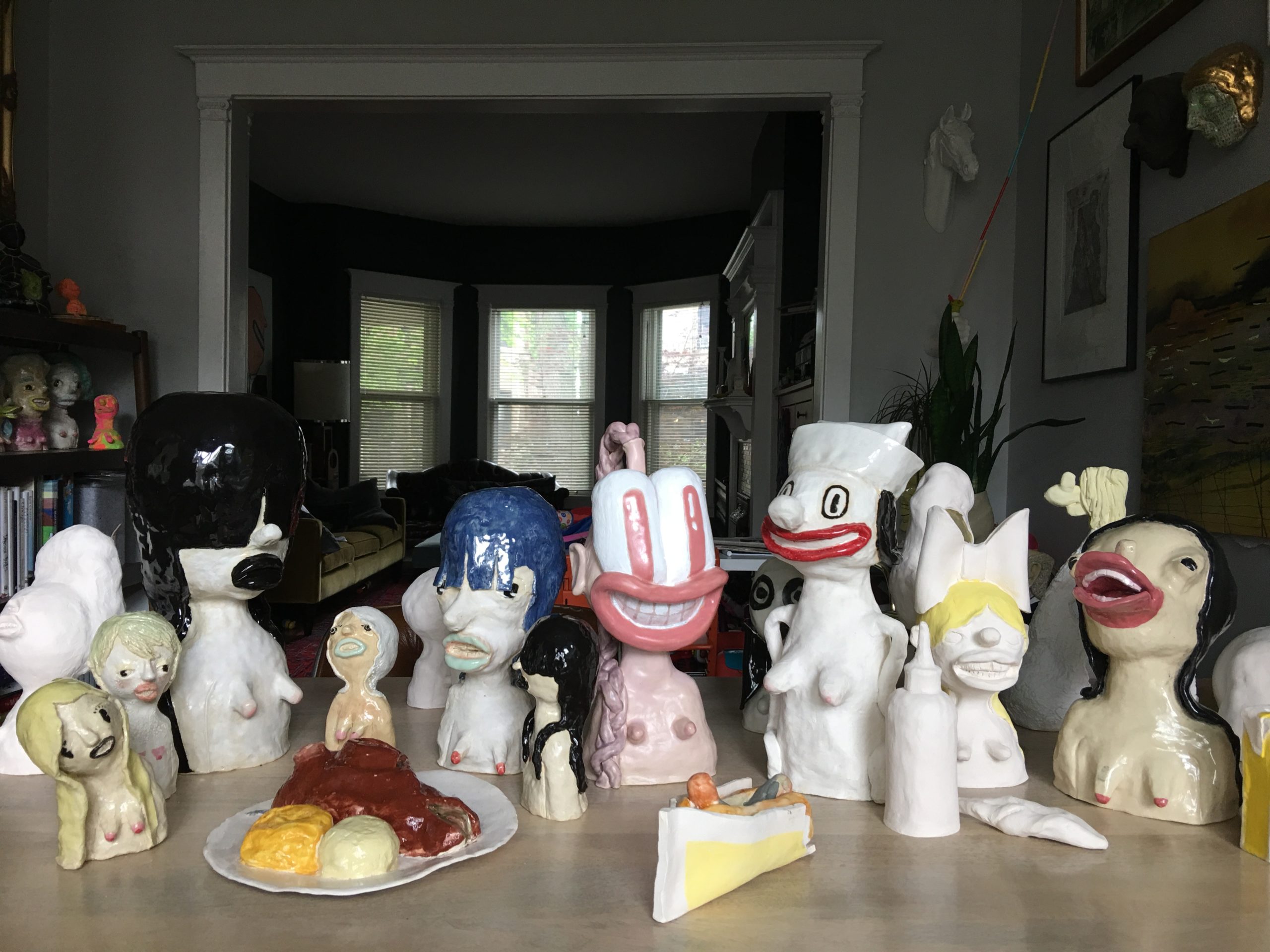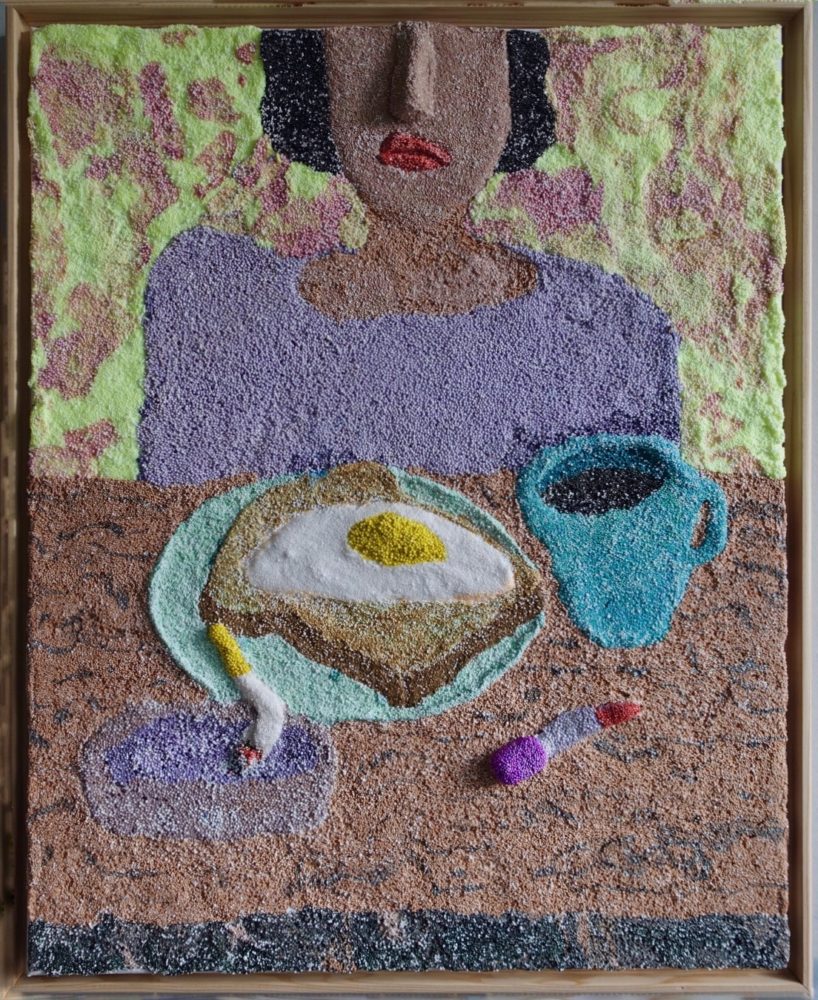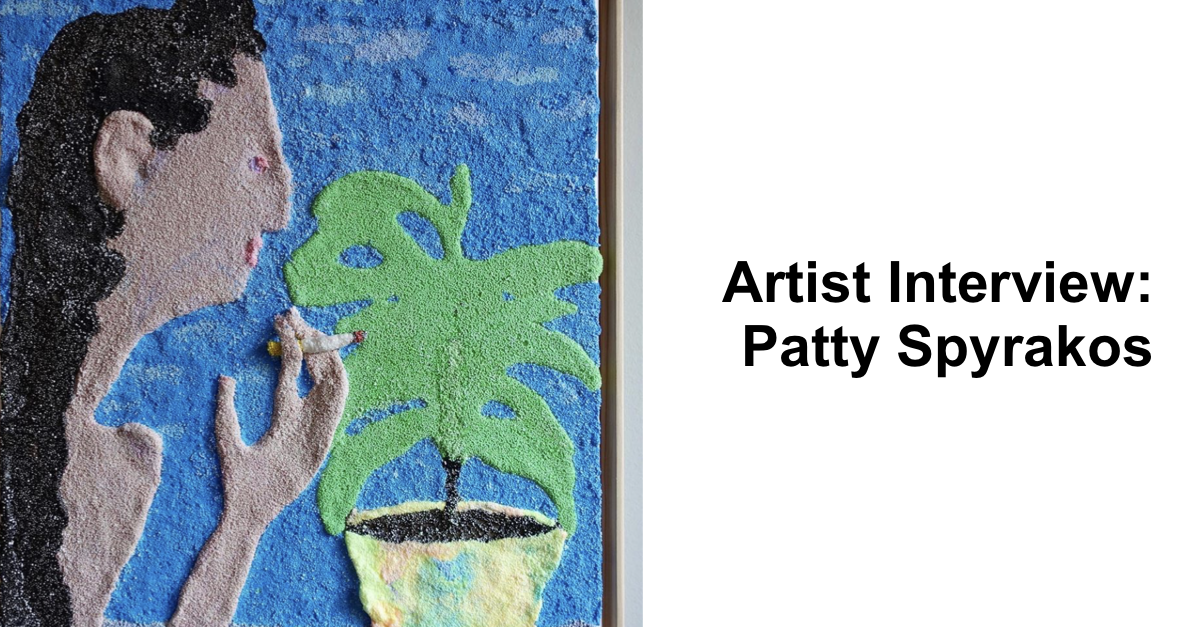Patty Spyrakos
I SAW YOU POST ABOUT IT
January 3-February 2nd | 2020
Interview conducted by Katherine Whitlock



Patty Spyrakos’ cartoon-like characteristics of her female forms are meant to create a conflict of deep emotion vs emotional void. The cartoon form is non-realistic, caricature – a disconnect from ego, yet the figures attempt to engage the properties of the limbic system which focuses on memory, basic emotions (fear, pleasure, anger) and drives (sex, hunger, care of offspring). Patty has a background in Psychology and traditional Chinese medicine and Herbalism (jackpot!) that left me wanting to know more about, well, everything she does!
Katherine Whitlock– Does the act of painting start in your brain and make its way to the surface, or does it start on the surface and reveal itself as you go?
Patty Spyrakos– I think it always starts in my brain. I’m in a pretty constant state of existential frustration. I’m constantly turning over different ideas before I commit to them. Sketching, re-sketching, pondering, reviewing, and then trying out what most resonates at the time of production. I’d say half of the time I start with applying paint to paper and create for as long as I can before I start over-analyzing. If I have a very set idea based on preliminary sketches then I might lightly sketch out what I’m about to, or think I’m about to paint. For the most part though, from the moment the paint touches the surface, there’s a lengthy series of arguments with myself that try to find a balance between intent vs. chance. I try to leave some time in the end for dreaminess though– battle’s over, and now I can allow myself to play. It also depends on the medium. The mental process is pretty similar but the content is swayed depending on whatever material I’m using to sculpt or paint. I’m “painting” with my own version of floam lately (basically glues, polyvinyl alcohol, polystyrene beads, and paints). It’s a nice mix of sculpture and painting. Also, once the liquids have dried off the beads appear to be holding themselves together, like magnified atoms, or particles. It’s a bit like, “we’re all one-man” but at the same time, there are energies, ideas, and persuasions acting as filters to create the force of the thing.
KW- What part of your body has control of the way gesture appears? or how color appears? is it your brain? heart? hand? intestine?
PS- Random hand movements, voluntarily and involuntarily, manipulated by my mental state control the gesture. In addition to my horrible posture! After that, I’ll usually babysit a gesture and it can change a lot. I think that’s where the heart comes in.
KW- Can you elaborate a little bit more on the figures and their attempt to relate to the human limbic system? Is there a specific color or gesture that relates specifically to an emotion, or is it the totality of the work that is meant to evoke a single visceral sensation?
PS- I think me relating the sculptures to the limbic system was a bit of me trying to reconcile my artwork with my past in psychology (I studied neurobehavioral psychology in college). I don’t think the figures started with that idea, but I later saw the link. The limbic system is involved in memory, basic emotions (fear, pleasure, anger), motivation and drives (sex, hunger, care of offspring) and I see the cartoonishness of the figures as a psychical manifestation of female thru the limbic system. Her memories of terrible things (the expressions), her motivation to be both cerebral (large head), and a mother (mammaries). Mostly I think all this stuff is just motivated largely by my own limbic system. We also know that the limbic system peaks when one has hallucinations or mystical experiences, and I think that’s where a lot of the content of the newer sculptures I’ve been working on comes from.
KW- Can you elaborate on the woman’s role in your paintings? Whether the woman is a blanket symbol for a child-bearer, loyal friend, passive leader by association, emotive powerhouse, etc
PS- The figures started out as an idea of the female reduced to a passive observer, divided between being the mother and the whore. Breasts and lips are most prominent – acting to replace arms as the ruling appendage in the weight they are given. The female is reduced to something meant to suck and be suckled. But then about a year ago I went to this bodyworker and spiritual healer in Iceland. I went a couple of times, and I came out feeling like the message needed to change if I wanted to change. But I wasn’t sure how, and it kind of left me in limbo with my work for many months. I’m still climbing out of that ‘hole’ but I guess that was part of the journey. That, or maybe I should have had a few more sessions! Anyhow, that’s likely why in some of my newer paintings the female is in more of a self-reflective state, more empowered, unafraid to show her flaws, she’s stopped pretending and is like ‘what’s the next move?’. I also removed some of the anxiety within them and placed it in an object outside of them, usually the source of the anxiety, like something’s always lurking. All of this is conceivably mostly the collective unconscious at work.
KW- What is your favorite food? Does it influence your paintings?
PS– Vegetarian Indian and brothy soups, but I don’t get to eat enough of either. There’s a lot of eating my kid’s leftovers, or whatever’s easiest these days. I think food’s main influence on the work is how my gut bacteria is affecting my brain. However, the show I did in Iceland was motivated greatly by some of Iceland’s favorite comfort foods (hot dogs, a specific brand of chocolate milk, kleinur (donuts), sheep’s head). I had a lot of fun with those. Titles of earlier figures were based on fast food promotional signage, mostly because I would pass a White Castle on the way to my ceramics studio and the names of the food items were ridiculous.
KW- Speaking of guts and food, what is your favorite adaptogen?
PS- I went to this fantastic herbalism school here in Chicago for a little over a year. We learned to identify and harvest herbs, commune with them, make tinctures, studied their chemical constituents, medicinal properties, and mostly learned how to use them in treatment through the lens of Chinese Herbal Medicine. While I don’t have time these days for tincture making, I take echinacea pretty frequently to keep from getting all the colds/touches of flu my kids get and take an assortment of herbal remedies from a Finnish based company that my mother in law in Iceland imports and sells (Birkiaska.is). I take one of their metabolic detox remedies that are rich in Birch leaves, Pomegranate juice and Green Tea extract on a daily basis, another for menstruation that is primarily made up of the female flowers of Hops. And passionflower is always great for relaxing the brain.
KW- Is it weird to ask who your favorite psychologist is (you don’t have to answer that!)?
PS- Alix Spiegel, Hanna Rosin, and Lulu Miller do an outstanding job with Invisibilia in uncovering the forces that control human behavior. From a classical/traditional perspective, Jung; for quantum psychology Robert Anton Wilson; personally, Mary Jean P. – the therapist I had in SF 10 years ago; David Lynch – for fear, existential crisis, creativity, etc… I’ve also been meaning to take up Transcendental Meditation. And recently, for grief, I’ve started reading Nick Cave’s Red Hand Files blog (of course, as I’m writing this, I checked the site and saw that his last answer to someone was to take up TM!)
Also recently discovered Naomi Weisstein, a neuroscientist, and feminist that taught at Loyola Univ (where I studied); she was known largely for her feminist work critiquing psychology’s treatment of women.
Contact Gallery Director Matthew Gardocki for purchase info:
info@laluzdejesus.com (323)666-7667
